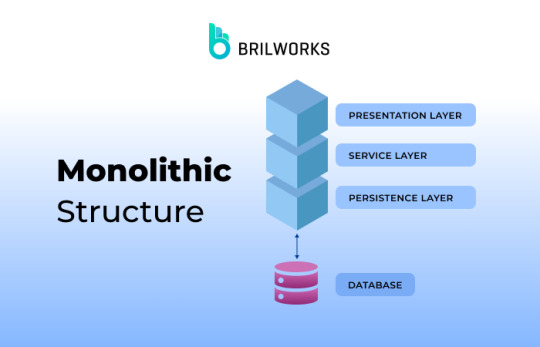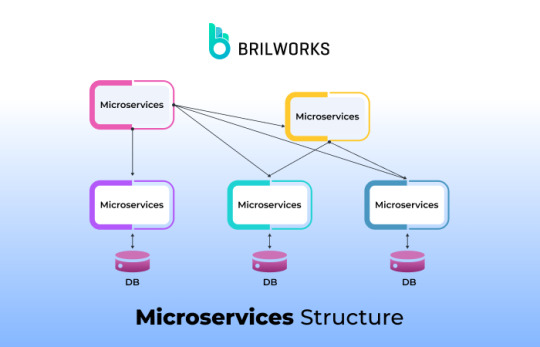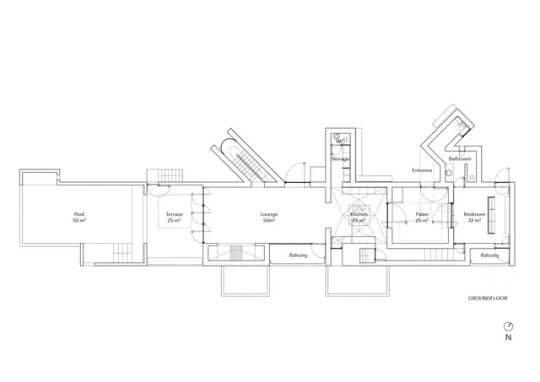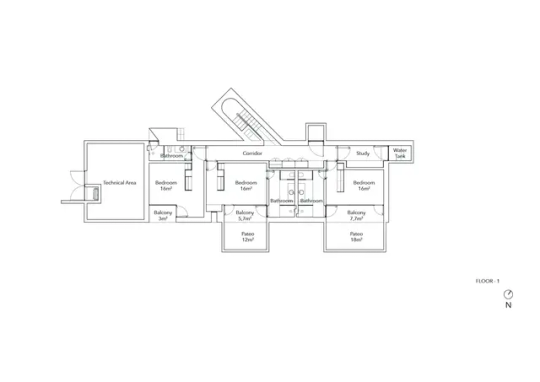#monolithic architecture
Explore tagged Tumblr posts
Text
What Everything You Need to Know About Microservices

Introduction
Just like technology, architectural style is a crucial concern in software development. This is why understanding different architectural patterns is important. While it may not be possible to cover all patterns in a single article, the focus of this particular article will be on microservices.
In this article, we will discuss what microservices are and the key differences between monolithic and microservices architectures. We will also discuss the benefits and disadvantages associated with Microservices.
By the end of this article, you will better understand microservices architecture and its benefits. You will also be able to decide whether microservices architecture is the right choice for your next project.
Monolithic vs. Microservices
Monolithic Structure
To understand Microservices fully, we need first to understand monolithic structures. It is more traditional architecture. Monolithic architecture is a time-tested approach that involves building everything as one big application.

Microservices
Microservices, on the other hand, are individual, self-contained services that can be deployed and scaled independently that involve breaking down an application into a bunch of smaller, independent services.

Why Microservice?
For small business owners, it can be a pain to scale if your app has monolithic architecture.
When you approach a company for application development, they will likely ask you about the architectural style you want to use. This is an important decision, as it can have a significant impact on the development cost and scalability of your application.
Monolithic architectures are simpler to develop and maintain, but they can be difficult to scale. If one part of the application becomes overloaded, it can affect the entire application. Microservices architectures are more complex to develop, but they are more scalable. If one service becomes overloaded, it will not affect the other services.
Here is an example to help you understand the difference between monolithic and microservice architectures.
Imagine you have a social media app that has user management, posting, commenting, and liking features. If one service, say user management, gets a lot of traffic, it will use more resources and affect the other services. This is because all the services are tightly coupled together. To fix this, you would need to scale the entire application, which can be time-consuming and expensive.
A better approach is to break the services down into microservices. This means that each service will be responsible for a specific task, such as user management, posting, or commenting. This makes the services loosely coupled, which means that if one service gets overloaded, the others will not be affected. This makes it much easier to scale the application because you can simply scale the individual services that need it, not the entire application.
Characteristics of Microservices
Autonomy: Microservices exhibit loose coupling, enabling independent deployment, development, and scalability. This facilitates the effective management and maintenance of microservice-based applications.
Componentization: A prevailing approach involves dividing a system into smaller components. This permits individual focus on specific services or components, enabling independent modification and deployment without compromising the overall integrity of the application.
Specialization: Each service is designed to address a specific problem or provide a distinct set of capabilities. If a service becomes overly complex, it can be further broken down into smaller, more specialized services.
Benefits of Microservices
1. Agility
Microservices promote agility by dividing project work into small, independent teams. This approach allows each team to focus on a specific aspect of the application without affecting the other teams. This results in more efficient and faster work, as each team can work independently and focus on their own tasks.
Although working together can also be productive, having independent teams working simultaneously can reduce the development cycle. This is because each team can work on their own tasks without having to wait for the other teams to finish their work. This allows us to develop more customer-ready applications in less time.
2. Flexible Scaling
E-commerce platforms and other service-based applications often require frequent scaling of their systems. However, smaller companies may find it costly and labor-intensive to allocate more resources and scale the entire application. In contrast, microservices have gained popularity because they offer flexible scalability. This is why tech giants like Amazon, Netflix, eBay, and others have adopted microservices to achieve flexible scaling.
3. Easy Deployment
Loose coupling of services also promotes the easy deployment of applications by enabling the deployment of specific services that have undergone continuous improvements. This eliminates the need for developers to extensively rework the entire codebase. As a result, businesses can effortlessly include new features as required without significant effort.
4. Technological Freedom
In a microservices architecture, teams can choose the tools and technologies that work best for them. This means that they can use the latest tools, or they can stick with tried-and-true solutions. They can also use a mix of different tools, depending on the specific needs of each microservice.
For example, you start building a microservice that requires storing a lot of data. You could use a traditional relational database, but this might not be the best choice. Relational databases are not designed for high-performance storage, so you might end up with a slow and inefficient microservice.
Instead, you could use a NoSQL database, which is specifically designed for high-performance storage. NoSQL databases are more flexible than relational databases, so you can choose the right data model for your needs. This will lead to a faster and more efficient microservice.
The flexibility of microservices architecture allows you to mix the best tools and technologies for the job.
5. Reusable Code
Imagine you have a big piece of software that does many different things. Instead of having all the code in one huge chunk, you divide it into smaller, well-defined parts called modules.
These modules are like building blocks that have specific functions. For example, one module might handle user authentication; another module might handle database operations, and so on. Each module can be used independently to perform its specific task.
Now, the good thing is that these modules can be reused in different parts of the software. So, if you have a module that handles user authentication, you can use it not only in one part of the software but also in other parts that require user authentication. This saves time and effort because you don’t have to write the same code multiple times.
Similarly, in a microservices structure, you can reuse services if the same functionality is needed in different parts of the software. This promotes efficiency by avoiding redundant code and allowing the same service to be utilized in multiple areas as needed.
6. Resilience
With microservices, applications are divided into smaller, independent services that work together. If a single microservice doesn’t work, it doesn’t bring down the entire application. Instead, the application gracefully degrades its functionality, meaning it can still continue operating to some extent without crashing completely.
Why Spring for Microservices
Microservices can be developed using various programming languages and technologies. However, one of the most widely used frameworks for building microservices is Spring Boot using Java/Kotlin. Spring Boot has gained popularity for various good reasons.
Building microservices using SpringBoot is effortless and fast.
Spring Cloud provides tools for devs to build some of the common patterns in microservices in no time.
It comes with production-ready features like metrics, security, and embedded servers.
The Spring community is massive. If you ever get stuck, there are plenty of Spring developers out there to help you out.
Challenges With Microservice Architectures
Microservices are not all sunshine. Though they are great for scalability and flexibility, they also come with a few challenges. Let’s take a look at some of the inherent complexities of microservices architectures.
Automating the Components: The number of smaller components in a microservices architecture can make it difficult to automate everything. This includes builds, deployments, and monitoring. It is important to have a solid automation strategy in place to ensure that all of the components are managed effectively.
Perceptibility: The distributed nature of microservices can make it difficult to monitor and identify problems. It is important to have good visibility into all of the components in order to troubleshoot issues quickly. Centralized logging and dashboards can help to improve perceptibility.
Configuration Management: The configuration of microservices can be complex and difficult to manage. It is important to have a centralized configuration management system in place to ensure that all of the components are configured consistently. This will help to avoid errors and inconsistencies.
Debugging: Debugging microservices can be challenging because there are so many moving parts. It is important to have a good understanding of the architecture and how the components interact. Centralized logging and dashboards can also help with debugging.
Consistency: It is important to have some consistency in the way that microservices are implemented, deployed, and monitored. This will help to avoid chaos and make it easier to manage the architecture. However, it is also important to allow for some innovation and flexibility.
Read more at https://www.brilworks.com/blog/everything-you-need-to-know-about-microservices/
0 notes
Text


















Frame House, Santa Bárbara de Nexe, Faro, Algarve, Portugal,
Pedro Domingos Architect
#art#design#architecture#minimalism#minimal#interiors#brutalism#monolith#brutalist architecture#portugal#algrave#faro#frame house#pedro domingos#santa barbara de nexe#Retreat
96 notes
·
View notes
Text

Monolith.
#new topographics#salamanca#abandoned#natural light#decay#urbex#industrial architecture#liminal aesthetic#industrial archeology#industrial decay#monolith
92 notes
·
View notes
Text

USHIDA FINDLAY ARCHITECTS TRUSS WALL HOUSE, 1993 Tokyo, Japan Images via OfHouses
#architecture#design#architect#designer#art#archdaily#artwork#photography#juliaknz#form#japanese houses#porous monolith#kathrin findlay#british architect#urban context#material#dezeen#monolith#house
71 notes
·
View notes
Text

Споменик Космајском партизанском одреду The Monument to the Fallen Soldiers of Kosmaj Mount Kosmaj, Serbia Designed by Vojin Stojić and Gradimir Medaković, 1971 Ph. Jovana Mladenović
Scattered across the landscapes of the former Yugoslavia, monumental sculptures rise in silence. They are remnants of a vision that once unified a region through art and remembrance. Designed by modernist architects in the mid-20th century, these striking brutalist structures were commissioned to honor the sacrifices of those who perished in World War II. More than memorials, they embodied a futuristic aesthetic, symbolizing strength, unity, and a forward-looking optimism. Serbian photographer Jovana Mladenović revives these forgotten relics in her series Monumental Fear, capturing their haunting beauty and enduring presence. “The idea is that it is the story inside the monument, representing all of those dead soldiers,” she explains. “A lot of people died in the war, but there are no records.” Among her most striking works, ballerina Milena Ogrizović, draped in red beside the Monument to the Fallen Soldiers of Kosmaj, forms a chapter Mladenović calls “The Star.” The juxtaposition of movement and monumentality embodies both fragility and defiance.
#kosmaj#fallen soldiers of kosmaj#planina kosmaj#brutalism#monument#spomenik kosmaj#spomenik#balkan#serbia#srbija#kosmaj monument#modernist architecture#modernist monuments#modernism#futurism#monolith#red#photography#beautiful#ex yu#ex yugoslavia#history#ww2 history
30 notes
·
View notes
Text

Necrons vs Tau
by Jaime Martinez
#necrons#destroyer cult#monolith#doom scythe#ghost ark#tau#vior'la#fire warrior#battlesuit#stealth battlesuit#xenos#battle#architecture#jaime martinez#40k
72 notes
·
View notes
Text

Ziggurat by Pat Presley
90 notes
·
View notes
Text

Via print:

#art#digital art#aesthetic#scifi#cyberpunk#science fiction#sci fi#scifiart#futuristic#scifi art#sci fi and fantasy#scifi aesthetic#sci fi horror#scififantasy#scifi and fantasy#scifi aesthetic art#scifi dystopia#dystopian#dystopia#dystopic#monolith#monolith art#brutalism#brutalism architecture#brutalism architecture art#brutalism art#brutalist#brutalist architecture#fields#futuristic architecture
21 notes
·
View notes
Text

Monoliths no. 1, King and Younge, Toronto.
By Lawrence Bernstein
2024 Black And White Minimalism Photography Awards
#lawrence bernstein#photographer#black and white minimalism photography awards#black & white photography#monoliths no 1 king and younge toronto#architecture
4 notes
·
View notes
Text

The Great Sphinx of Giza, one of the oldest and largest monolithic statues in the world!
𓃭
#history#great sphinx of giza#ancient egypt#old kingdom#art history#thutmosis iv#monolithic statues#royalty#pyramids of giza#world wonder#ancient egyptian history#landmarks#new kingdom#historical figures#giza#ancient#egyptology#architecture history#travel girl#ancient egyptian#art#statues#monument#ancient history#nickys facts
3 notes
·
View notes
Text

Gasolinera abandonada en Roperuelos del Páramo (León). En la carretera nacional N-VI.
#new topographics#abandoned#natural light#decay#urbex#liminal aesthetic#industrial architecture#industrial archeology#industrial decay#altered landscape#gas#gasolinera abandonada#gasolinera#gas station#monolith#sky#plain
4 notes
·
View notes
Text

KARL SCHWANZER BMW OFFICES, 1973 München, Germany Image © Bundesarchiv B 145 Bild-F062779-0027
#architecture#design#architect#art#archdaily#designer#artwork#photography#juliaknz#form#monolith#karl schwanzer#austrian architect#building#munich#bmw#urban space#space#context#facade#highrise
91 notes
·
View notes
Text
youtube
Monolithic vs Microservices — What Should You Build
Choosing the wrong architecture too early can cost you years of tech debt! Not every product needs microservices Not every startup should start monolithic Let’s break it down :- ❓When will you need Monolithic architecture? Monolith is focused, fast, and manageable ✅ You’re building an MVP or early-stage product ✅ Your app is simple, with tightly coupled features ✅ You need to launch quickly with a small dev team ✅ Deployment speed matters more than modularity ❓When will you need Microservices? Microservices are scalable, flexible, and complex ✅ You’ve scaled and need feature-specific deployments ✅ Your teams work on different modules in parallel ✅ You want fault isolation and independent scaling ✅ Continuous deployment and DevOps are in place ⚠️ Don’t follow trends. Follow your product’s stage and your team's capability. Get expert guidance tailored to your tech stack and business goals. Call - +91 9073754444 or book a FREE consultation - https://wseinfratech.com/book-a-free-consultation
#distributed systems#microservices#java#monolith#monolith vs microservices#what is microservices#monolithic application#website development#software development#software development company#custom software development#custom website development#java microservices#web development company#aws microservices#api#api gateway#monolithic structure#website architecture#what is api gateway#web development planning#building api#custom software#custom website#Youtube
1 note
·
View note
Text
Monolith to Microservices – How Database Architecture Must Evolve

The journey from monolith to microservices is like switching from a one-size-fits-all outfit to a tailored wardrobe—each piece has a purpose, fits perfectly, and works well on its own or with others. But here's the catch: while many teams focus on refactoring application code, they often forget the backbone that supports it all - database architecture.
If you're planning a monolithic to microservices migration, your database architecture can't be an afterthought. Why? Because traditional monolithic architectures often tie everything to one central data store. When you break your app into microservices, you can't expect all those services to keep calling back to a single data source. That would kill performance and create tight coupling. That’s the exact problem microservices are meant to solve.

What does evolving database architecture really mean?
In a monolithic setup, one large relational database holds everything—users, orders, payments; you name it. It's straightforward, but it creates bottlenecks as your app scales. Enter microservices database architecture, where each service owns its data. Without this, maintaining independent services and scaling seamlessly becomes difficult.
Here is how Microservices Database Architecture looks like:

Microservices Data Management: Strategies for Smarter Database Architecture
Each microservice might use a different database depending on its needs—NoSQL, relational, time-series, or even a share database architecture to split data horizontally across systems.
Imagine each service with its own custom toolkit, tailored to handle its unique tasks. However, this transition isn't plug-and-play. You’ll need solid database migration strategies. A thoughtful data migration strategy ensures you're not just lifting and shifting data but transforming it to fit your new architecture.
Some strategies include:
· strangler pattern
· change data capture (CDC)
· dual writes during migration
You can choose wisely based on your service’s data consistency and availability requirements.

What is the one mistake teams often make? Overlooking data integrity and synchronization. As you move to microservices database architecture, ensuring consistency across distributed systems becomes tricky. That’s why event-driven models and eventual consistency often become part of your database architecture design toolkit.
Another evolving piece is your data warehouse architecture. In a monolith, it's simple to extract data for analytics. But with distributed data, you’ll need pipelines to gather, transform, and load data from multiple sources—often in real-time.
Wrapping Up
Going from monolith to microservices isn’t just a code-level transformation—it’s a paradigm shift in how we design, access, and manage data. So, updating your database architecture is not optional; it's foundational. From crafting a rock-solid data migration strategy to implementing a flexible microservices data management approach, the data layer must evolve in sync with the application.
So, the next time you’re planning that big monolithic to microservices migration, remember: the code is only half the story. Your database architecture will make or break your success.---
Pro Tip: Start small. Pick one service, define its database boundaries, and apply your database migration strategies thoughtfully. In the world of data, small, strategic steps work better than drastic shifts.
Contact us at Nitor Infotech to modernize your database architecture for a seamless move to microservices.
0 notes
Text

Spear of Macragge
by Wonchun Choi
#imperium#adeptus astartes#astartes#ultramarines#necrons#monolith#xenos#tank#vehicle#bolter#battle#architecture#wonchun choi#40k
40 notes
·
View notes
Text












REIULF RAMSTAD ARKITEKTER - HOUSE OF GRAIN
#REIULF RAMSTAD ARKITEKTER#architecture#cultural#cultural center#terracotta facade#terracotta#wood#building in landscape#monolithic
1 note
·
View note